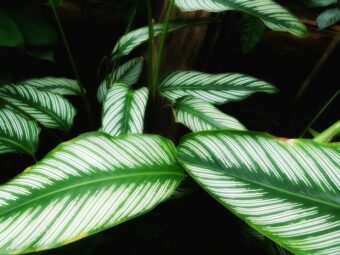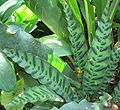In this article, we will be discussing how to grow and get the best from your calatheas. Calatheas are plants that are grown for their beautiful, colourful leaves that will certainly brighten your home, especially if you get the growing conditions right.

They tend to be more trouble than other houseplants but this does not mean that you cannot grow them, especially if you get the watering right. You will find out in this article, how to grow calatheas, the best growing conditions, the varieties to grow and the pitfalls to avoid.
WHAT IS CALATHEA?
It is a popular indoor plant used to brighten homes with its papery foliage of bold block, blobs of colour and thin stripes that are often in shades of green and white. It is not only the flashy colour of the leaves that impress but the shape and form as well. Some are large and round, whilst others are extremely elongated.

It is a tropical plant from tropical areas such as Africa and belongs to the family Marantaceae (the arrowroot family). It is one plant that can grow in areas of low light as they use their broad leaves to absorb as much light as possible. This is because they are often found in the jungles and at the base of trees, so they need to be efficient in their absorption of light.
THE BEST GROWING CONDITIONS AND CARE TO GIVE YOUR CALATHEA PLANTS
As said in the introduction, calatheas can be difficult to grow as they need a warm. Uniform temperature and high humidity all year round. This can be difficult to achieve in the home, but with due cause and attention, they will not only survive but flourish.
LIGHT
Calatheas prefer to be grown in anything from light shade to bright, indirect sunlight. This is, of course, dependent on the variety grown and its growing preference. Do not place them in direct sunlight as this will scorch the leaves and cause the plant to lose its vibrancy in colours.
TEMPERATURE

This is one houseplant that does not like cold temperatures, as they come from the tropics they like warm temperatures all year round (anything between 18 and 27 degrees Celsius). Too high temperatures can cause the plant to dehydrate quickly, causing the leaves to curl. At low temperatures, the plant will suffer and can start losing leaves. Not a pretty look.
WATERING
Calatheas need to be watered well from spring to autumn, more sparingly in winter. It is best to water with soft, tepid water. Hard water can be problematic for the plants. Calathea like the compost to be moist, not soggy. Do not water too much so that the plant sits in water, as this will lead to root rot and the slow death of your plant.
It is best to water calatheas when 5cm below the top of the surface of the compost feel dry when you stick your finger in. Water until it emerges from the drainage holes and then stop. Throw away any water that accumulates in the saucer after half an hour.
HUMIDITY
Caltheas like the humidity to be high as it will replicate their natural growing conditions in the jungle. It is advised that you mist the plants regularly or you can place the plant on a tray of moist clay balls that will naturally increase the humidity around the plant.
FERTILIZER
They prefer to be fertilized with standard houseplant fertilizer such a baby bio during the growing season from spring to autumn. It is recommended to feed them monthly whilst the plant is in active growth.

Most calatheas tend to grow fairly slowly and so will not be much of a problem in their pots. They can grow anywhere from 50cm to 300cm and then stop. They do not need any pruning, but any yellow oy brown leaves can be removed to give a better appearance to the plant. Calatheas indoors tend not to flower as they do in their natural home, but one species Calathea crocata produces beautiful orange blooms. The others are grown for their colourful leaves and different forms
Calatheas can be temperamental if you get the growing conditions wrong. Most problem that results from calatheas is from watering issues, too much light, wrong temperatures or too low humidity levels.
If you water right with the right type of water, keep the temperature and humidity right, at the right level of light, you will have a beautiful, vibrant plant.
VARIETIES TO GROW
CALATHEA LANCIFOLIA (Rattlesnake Plant)

This calathea has long narrow, spear-shaped leaves that are wavy-edged and purple blow. Above the leaves, it has a snake-like pattern. It will tolerate cooler conditions than most calatheas and will take more frequent changes of temperature. To do this it needs moderate humidity and slight shade.
CALATHEA MAKOYANA (Peacock Plant)
The plant has spear-shaped leaves with a feathery pattern on a silvery background and is flushed red below. This plant does well mixed with other houseplants where the beauty can be seen if it is given some light, but not too much bright light.
CALATHEA ORNATA
This plant has spear-shaped leaves that are delicately lined in a herringbone fashion, pink to white against a dark green background, purplish below. The bright leaf colour may be lost with age and if exposed to too much light. Restrict size by feeding less generously.
CALATHEA ORBIFOLIA

This plant has numerous and very attractive large, broad round silvery striped green leaves. Not a difficult plant to look after, where it will grow to 1m tall.
CALATHEA ROSEOPICTA

This is a classical variety that has beautiful large dark green leaves that are banded with silver and emerald green. The back of the leaves are a deep red-purple that enhances the plant, where it can grow up to 60cm in height.
CALATHEA RUFIBARBA (Velvet Calathea)

This is an unusual variety of calathea that is soft to the touch. The leaves tend to be long and stretched and are not as bright as a lot of the other calathea. The leaves are a rich green on top and dark burgundy underneath. A plant that will enhance most homes.
CALATHEA ZEBRINA (Zebra Plant)

This is a plant that has long leaves with a velvety texture and a zebra-striped pattern on top. Below the leaves are purplish and when fully grown look like a palm. The leaves in ideal conditions can grow up to 30cm long, which could be half the size of a fully grown plant. Not an easy plant to look after. If the compost is allowed to dry out, it will cause the plant to deteriorate, never to recover. Draughts and temperature fluctuations can be fatal.
CONCLUSIONS
In this article, we have discussed how to get the best from your calathea. We have talked about the varieties to grow and the best growing conditions to keep your plant healthy and looking its best. They can be difficult plants to look after, especially if you do not get the temperature, humidity, light and watering requirements right.
They are such colourful houseplants that I recommend that everybody should have one in their home. It will certainly brighten it up.
If you have any questions or comments that you wish to make, please do so in the comment box below.
Happy Calathea Growing.
